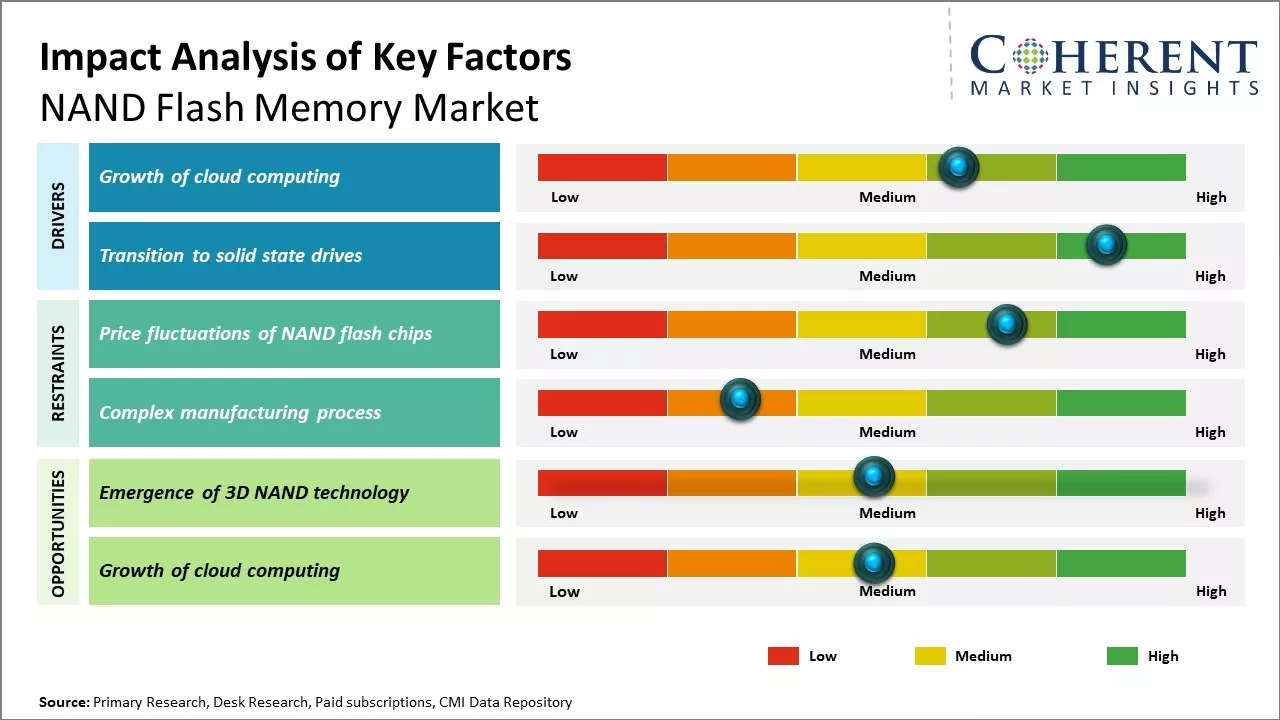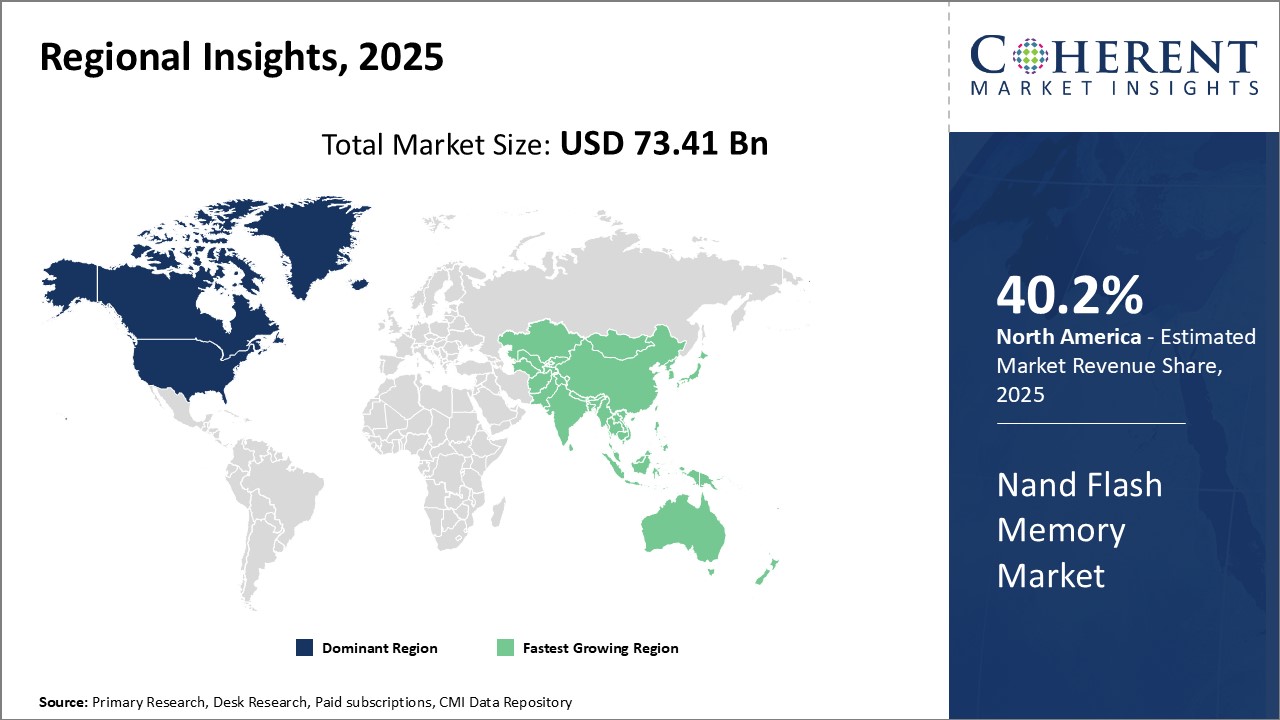The NAND flash memory market is estimated to be valued at USD 73.41 Bn in 2025 and is expected to reach USD 109.01 Bn by 2032, exhibiting a compound annual growth rate (CAGR) of 5.8% from 2025 to 2032.
The widespread use of smartphones, tablets, and other portable devices is driving robust demand for higher storage capacities. NAND flash is increasingly being used in data centers to power the growth in cloud computing and the need for massive data storage.
The market is expected to be driven by the rising demand for storage in consumer electronics such as smartphones, tablets, and SSDs. Increasing utilization of multimedia-rich content and huge storage requirements of next-generation technologies such as artificial intelligence, augmented reality, and virtual reality will augment the demand for NAND flash memory. Expanding use of flash storage in automotive electronics is another key factor expected to support the market growth over the forecast period.

To learn more about this report, Download Free Sample
|
Current Events |
Description and its Impact |
|
U.S. Export Control Expansion Targeting Advanced Semiconductor Manufacturing in China
|
|
|
China’s Aggressive Domestic NAND Production Expansion
|
|
Uncover macros and micros vetted on 75+ parameters: Get instant access to report
Artificial Intelligence (AI) is playing an increasingly vital role in the NAND flash memory industry.
The explosion of digital content is driving an exponential need for storage, met primarily by compact, fast NAND flash memory. This demand stems from more phone storage, smart devices, cloud computing, and emerging data-heavy tech like AI and VR. This digital surge will vastly increase global data and propel flash memory growth.
SSDs, powered by NAND flash, are replacing HDDs due to their superior speed, power efficiency, and durability. Their faster performance is crucial for modern computing, and their shock resistance makes them more reliable. As SSDs get cheaper and larger, more devices are adopting all-flash setups, greatly benefiting NAND flash suppliers and boosting demand.
Global demand for high-capacity storage is set to rise, propelled by data-intensive applications like AI, autonomous vehicles, and IoT. Faster NVMe interfaces and the popularity of smartphones/SSDs are also contributing factors. Cost reductions per gigabyte are expected as TLC and QLC technologies become more prevalent. For instance, in early 2025, major SSD makers like Samsung and Micron launched new QLC NAND products, showcasing increasing capacity and falling costs.
In terms of type, TLC segment is expected to contribute the highest share of the market, accounting for 33.0% in 2025 to its significantly lower cost per bit compared to other types. Storing 3 bits per cell rather than 1 or 2 bits allows TLC NAND to achieve a much higher density and reduce manufacturing costs. This cost advantage has made TLC the preferred choice for applications where storage capacity needs to be maximized at low prices, such as USB flash drives, memory cards, and SSDs in budget laptops and PCs.
Leading manufacturers have also steadily improved the write endurance and read/write speeds of TLC over the years, addressing earlier reliability issues. As a result, TLC NAND now meets the performance needs of most mainstream applications while keeping prices highly competitive.
In terms of structure, 3-D structure is expected to contribute the highest share, accounting for 68.8% in 2025 of the market as it allows manufacturers to meet the exponential growth in demand for NAND capacity. By utilizing a vertical stacking method known as vertical NAND technology rather than the conventional planar 2D layout, chipmakers can significantly boost the amount of NAND cells that can be fitted on a single die. 3D NAND's ability to sustain Moore's Law will ensure it remains the structure of choice as global data volumes show no signs of slowing in the coming years.
In terms of application, the highest share of the NAND flash memory market can be attributed to the smartphone segment, accounting for an estimated 31.9% in 2025. Smartphones have emerged as the most ubiquitous personal computing and multimedia devices, with over a billion sold annually. The massive data usage and local storage needs of modern smartphones is the single largest driver of NAND flash demand today. High-resolution photos and videos, huge app sizes, music libraries, and internal storage capacities upwards of 128GB all necessitate ever-larger NAND capacities in each new smartphone generation.

To learn more about this report, Download Free Sample
North America has established itself as the dominant region in the global NAND flash memory market. The region is expected to account for 40.2% of the market share in 2025. With the presence of major technology companies like Intel, Micron, Samsung, and Western Digital, the U.S. contributes significantly to the regional market size. In addition, the region is a major exporter of NAND flash storage solutions. The pricing of NAND flash chips from North American manufacturers also remains competitive in global tenders. This has further augmented their regional as well as global leadership.
The Asia Pacific region, especially China, is emerging as the fastest growing market for NAND flash memory. With a burgeoning consumer base and government initiatives to push digitization across sectors, the demand for storage devices is increasing exponentially. Rising domestic demand along with export opportunities to other Asian and African markets have made China an important location for memory production. It has also allowed the country to reduce import reliance and stabilize NAND flash costs. This makes Asia Pacific an attractive outsourcing and procurement hub. The region’s cost advantages complemented by improving quality standards are enabling it to gain ground.
The India NAND flash memory market is booming, driven by high demand for faster, higher-capacity storage in smartphones, IoT devices, and data centers. Key trends include the rapid adoption of advanced 3D NAND technology for increased density and performance, crucial for AI and cloud computing. The shift towards SSDs is also a major factor, though the industry faces challenges like supply chain fluctuations and continuous R&D needs.
The U.S. NAND flash market is expanding rapidly, primarily driven by strong demand for high-capacity, high-performance storage. Key factors include the dominance of 3D NAND technology, exponential growth in data centers and cloud computing, and the ongoing transition from HDDs to faster SSDs. While consumer electronics remain vital, the automotive sector and IoT applications are also significant contributors. The market faces cyclical challenges but remains a leader in innovation and adoption.
| Report Coverage | Details | ||
|---|---|---|---|
| Base Year: | 2024 | Market Size in 2025: | USD 73.41 Bn |
| Historical Data for: | 2020 To 2024 | Forecast Period: | 2025 To 2032 |
| Forecast Period 2025 to 2032 CAGR: | 5.8% | 2032 Value Projection: | USD 109.01 Bn |
| Geographies covered: |
|
||
| Segments covered: |
|
||
| Companies covered: |
Samsung Electronics, SK Hynix, Micron Technology, Intel Corporation, Kioxia Corporation (formerly Toshiba Memory Corporation), Western Digital Corporation, SanDisk (a division of Western Digital), Nanya Technology Corporation, Powerchip Technology Corporation, YMTC (Yangtze Memory Technologies Co., Ltd.), Intel-Micron Flash Technologies (IMFT), XMC (Xiamen Xinxin Semiconductor Manufacturing Corporation), Macronix International, Transcend Information, ADATA Technology, Phison Electronics Corporation, Silicon Motion Technology Corporation, Netlist, Inc., SK Hynix System IC, Inc., and GigaDevice Semiconductor (Beijing) Inc. |
||
| Growth Drivers: |
|
||
| Restraints & Challenges: |
|
||
Uncover macros and micros vetted on 75+ parameters: Get instant access to report
*Definition: The NAND flash memory market involves the manufacture and sale of NAND flash memory, a type of non-volatile storage technology that does not require power to retain data. NAND flash is used in USB flash drives, memory cards, solid-state drives, and other applications to provide removable and durable data storage. It has replaced hard disk drives in many devices due to its small size, low power consumption, high read and write speeds, shock resistance, and durability.
Share
Share
About Author
As an accomplished Senior Consultant with 7+ years of experience, Pooja Tayade has a proven track record in devising and implementing data and strategy consulting across various industries. She specializes in market research, competitive analysis, primary insights, and market estimation. She excels in strategic advisory, delivering data-driven insights to help clients navigate market complexities, optimize entry strategies, and achieve sustainable growth.
Missing comfort of reading report in your local language? Find your preferred language :
Transform your Strategy with Exclusive Trending Reports :
Frequently Asked Questions
Joining thousands of companies around the world committed to making the Excellent Business Solutions.
View All Our Clients